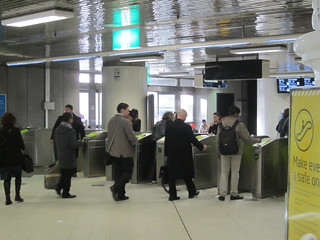 The Public Transport Users Association has slammed the Napthine Government’s announcement of a flat fare cap for Melbourne as a “lost opportunity” to reform fares in a sustainable direction, and as a longer-term hit on people in the suburbs that the scheme is supposed to help.
The Public Transport Users Association has slammed the Napthine Government’s announcement of a flat fare cap for Melbourne as a “lost opportunity” to reform fares in a sustainable direction, and as a longer-term hit on people in the suburbs that the scheme is supposed to help.
“If Premier Napthine really wanted to make public transport cheaper for people in the suburbs, almost any other way of doing it would work better than what he has announced today,” PTUA President Tony Morton said.
“By applying a Zone 1 fare cap right across the metropolitan area, the system is now forced to charge the same price to travel two streets away as to travel right across Melbourne,” he said. “So if the system has to charge more for the longest journeys in future, it’ll have to charge the same for a short trip too, even if there’s still a slight discount for Zone 2 relative to Zone 1.”
Dr Morton explained that when Zone 3 was abolished in 2007, fares quickly rose to claw back the difference. “Back in 2006 it cost $52.20 a week to travel in all three zones,” he said. “It now costs $60.60 a week to travel in two zones. The saving for those outer suburban travellers was eaten up within just five years, and we fully expect the same will occur for Zone 2 travellers with this measure.”
But the clawing back of revenue would spell bad news for single-zone as well as multi-zone travellers, Dr Morton said. “When there’s just one or two basic fares regardless of distance travelled, it rapidly becomes uncompetitive for short trips,” said Dr Morton. “The people likely to suffer in the longer term are those who want to use public transport to go to their local shops, to take the kids to school, or who work somewhere other than the inner city. In other words, the majority of people in Melbourne’s suburbs.”
“You may think paying between $2.48 and $3.58 full-fare each way to go a few blocks to the supermarket is already pretty steep,” Dr Morton said. “But once these become the only fares the system can charge for any trip, the only way they can go is up – a long way up, just as was seen in Adelaide where you now pay $9.40 for an all-day ticket.”
Better Services Needed
Dr Morton said the PTUA had heard from many members in Zone 2 who said the $100 million in revenue expected to be lost to the fare cap could be better spent on improved services. “$100 million a year could pay for a lot of suburban bus routes, or even a short rail extension,” he said. “Again, we don’t think the system will stand a cut to revenue of this magnitude for very long. But we shouldn’t be throwing away much-needed funds on such a counterproductive measure in the first place.”
Dr Morton also downplayed the proposal for free travel in the CBD and Docklands. “It’s simply not of relevance to anyone who uses public transport to get to the city, because they’re already paying a daily fare, so all their travel within the CBD is already free right now,” he said. “It may benefit those few tourists and CBD residents who never travel outside the CBD, but that’s a very limited number. The main beneficiaries will be those who drive cars into the city and catch the tram the last few blocks – we simply shouldn’t be designing the fare system to reward people for abandoning public transport and driving to the city instead.”
A Better Solution
Dr Morton said there were much better ways to set fares in a manner that is fair to passengers and competitive with car travel, but keeps public transport on a sustainable financial footing. “The biggest anomaly with our fare system at present is the way the price more than doubles when you go from Zone 2 to Zone 1,” he said. “This is why people currently drive to railway stations at the edge of Zone 1 and fill up the car parks there. We need to reduce the gap between the single-zone and multi-zone fare, but just abolishing it isn’t the way to go about it.”
“If we want to ease the burden of high fares then we need a reduction across the board,” Dr Morton said. “Most trips in Zone 2 don’t go outside Zone 2 – they won’t see any benefit unless the Zone 2 fare is cut.”
Dr Morton proposed that instead of applying the full benefit of the fare cut to just Zone 1+2 travellers, there be a reduction in each of the Zone 1, Zone 2 and Zone 1+2 fares. “But you would reduce the Zone 1+2 fare by a greater proportion, to reduce that enormous gap between the single-zone and multi-zone fare. So you would get the same revenue outcome, for example, if you cut Zone 1 and Zone 2 by 10%, and Zone 1+2 by 20%.”
“Ultimately though, we need to have a solid revenue base for public transport so we can run more services,” said Dr Morton. “The best way to do that is to encourage more people to use public transport. But many of those will be short-distance travellers, so it’s vital that fares be set to make these short trips competitive.”

